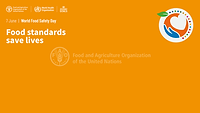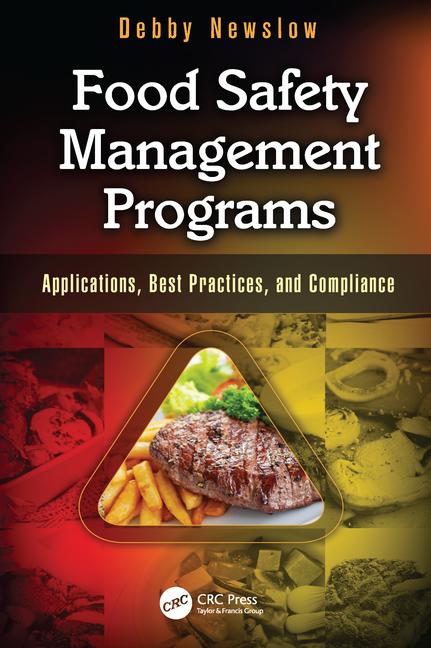The 7 Deadly Sins and 7 Heavenly Virtues of Food Safety: A Catechism of HACCP

Most discussions about food safety approach the subject from a scientific or managerial point of view. The dispassionate, scientific tone of these discussions leads to varying points of view and varying systems of prioritization. What is missing from these discussions is the realization that food safety is not simply another aspect of food quality. Instead, it is an issue of human morality: People die or become seriously ill from lapses in discipline.
In what follows, the sense of “right” and “wrong” in the practice of food safety is discussed, perhaps for the first time in print. The “Seven Deadly Sins” and “Seven Heavenly Virtues” of food safety are approached, not from just lists of seven items, but from the traditional foundations of human morality and ethics. It is hoped that by portraying the ethical problems of food safety in this manner, you will recognize the patterns of human behavior as the symptoms of the moral issues that underlie them.
WHY “SINS” AND “VIRTUES”?
Many experts consider “food safety” to be just one aspect of “food quality.” However, there are several key differences. “Quality” is a vague and all- encompassing term and is assessed from a standpoint of economics. It is measured on at least an ordinal scale, so the level of quality can be defined as “better” or “worse” than another level, based on some figure of merit, such as dollars of profit or cost. “Safety” involves the lives of real people. It is assessed from a standpoint of the nominal scale of “right” vs. “wrong,” not just economics.
Most people don’t realize that when a widespread multistate outbreak of food- borne illness with deaths occurs, the U.S. Department of Agriculture (USDA) or the U.S. Food and Drug Administration (FDA) automatically convenes a federal grand jury that can issue indictments related to the episode. “Criminal intent” is a term judged on the basis of “right” vs. “wrong.”
RIGHTEOUSNESS, SIN AND VIRTUE DEFINED
Before actions taken or omitted in food safety can be judged, a sense of “right” must be agreed upon. Although hundreds, if not thousands, of books and articles have been published on food safety and its current vogue methodology Hazard Analysis & Critical Control Points (HACCP), the overriding goal of food safety is never or rarely articulated. How can you steer a ship, if you have no compass?
Here is our mission statement for our food safety activities: “We will try, as far as is reasonably possible, to make sure every unit of food produced is safe for the consumer to eat.” The word “reasonably” will depend on current knowledge and available technology. It is well-understood by the courts, where it is the basis of defining the crime and tort of negligence. For our purposes, it means the judgment expressed by a jury of our peers in reviewing our actions after the fact. It also means the judgment inflicted upon ourselves by our consciences when we review “what might have been.” “Righteousness” is the performing of the duties implied by the mission statement for our food safety activities.
What are “sin” and “virtue”? Sin is defined as any willful thought, desire, word, action, omission or commission contrary to righteousness. To the U.S. Attorney investigating a mortal outbreak, sin is defined as “criminal intent,” “negligence” or “malfeasance.” To your peers, it is “unprofessional” or “irresponsible” conduct. Virtue is defined as a habitual and firm disposition to act righteously. It is pro-activism in the pursuit of “professional” or “responsible” behavior.
The “Axis of Evil” in food safety is: Money-Guilt—Fear. The problem with ethics in food safety is the obvious and overriding importance of economics to commercial activities. The issue of loss of profits typically corrupts professional standards and leads to “sinful” behavior. After the fact, fear of losing one’s job or other repercussions leads to cover-ups or further transgressions.
In addition to one’s own commission of sins, there are nine ways of being accessory to another’s sin. Part of righteous behavior is knowing how you can be tricked off the “straight and narrow path.” This happens: (1) by counsel (i.e., participation in the making of a decision); (2) by command (i.e., making the decision); (3) by consent; (4) by provocation (i.e., coercion into a wrong decision); (5) by praise or flattery (i.e., in support of a wrong decision); (6) by concealment; (7) by partaking; (8) by silence; and (9) by defense of the ill done.
When a new duty is imposed upon you (e.g., by regulation), the following stages of thinking are typical before acceptance of the duty is attained: (1) shock (when the duty is imposed); (2) denial (that the new duty is necessary); (3) anger (that the burden was placed); (4) depression (in shouldering the burden); (5) bargaining (to reduce the burden); (6) sadness (that the burden cannot be escaped); and (7) acceptance of duty. In each stage but the last, the opportunity for wrong actions is possible.
THE 7 DEADLY SINS
Human morals have been studied for thousands of years. Western civilization, at least, has codified wrong actions into seven categories:
Deadly Sin # 1: Pride or Arrogance. The Book of Proverbs cautions: “Pride goes before destruction, a haughty spirit before a fall.” The Greeks had a saying: “Whom the Gods destroy, they first make mad.” The sin of Pride evidences itself in food safety by a belief that can be summed up as, “It can’t happen to me,” “I know better than everyone else,” or “I want to do it myself in my own way.” Prideful behavior results in a NIH (“not-invented-here”) attitude. You worry about who “owns” specifications and the power of control, not about what results occur. You don’t fulfill your duties to food safety, because you “know” that they don’t matter and are just “make-work.”
Deadly Sin #2: Avarice or Greed. As is oft-quoted from the Book of Timothy, “The love of money is the root of all evil.” The sin of Avarice is a common one in food safety. A company is in business, after all, for the purpose of making money. Its management begrudges every dollar of profit lost to avoidable costs. Excessive attention to food safety is often viewed as an avoidable cost. Greedy behavior results in an attempt to salvage every unit of production, even if the sublot is suspect for safety reasons. You are unwilling to accept the loss as the price of doing your duty to food safety and try contorted means to justify avoiding it. Greedy behavior is recognized by its arguments after the fact, which stand out in a system of food safety that is supposed to be pre-planned. The sin of Avarice is the unwillingness to commit to the importance of safety over cost.
Deadly Sin #3: Lust or Unnatural Desire. The sin of Lust is the unnatural and self-destructive desire for goals in conflict with your duties. It occurs in food safety when you strive to build a system for its own sake, not that of safety. Lustful behavior is evidenced by an overly complex implementation, or a love of technology over effectiveness. Common sense is overridden for the sake of “bells and whistles.” The sin of Lust also can occur by its “flip-side”: the fear of the pain of duty, an unwillingness to face hard issues and make hard decisions.
Deadly Sin #4: Anger or Wrath. The sin of Anger is the ire raised against those who impose your rightful duties upon you. Wrathful behavior shows itself sometimes as defensiveness. You won’t brook criticism or learn from it. Wrathful behavior also appears as rebellion against duties and regulations instead of embracing them. You will recognize the sin of Anger when you hear arguments against duties, a refusal to take them seriously in a scoffing tone, and statements that the duties are burdensome or inconsequential.
Deadly Sin #5: Gluttony. The sin of Gluttony is an insatiable appetite that conflicts with the fulfillment of duties. In food safety, gluttonous behavior is the appetite for “bells and whistles” in the HACCP plan that diminish its effectiveness. It is the attempt to fold all of the quality and safety goals into one system, even though their goals conflict. Gluttonous behavior ignores the special importance of safety and considers safety is just one facet of quality. Gluttonous behavior is also marked by over-testing and inclusion of all control points as CCPs. You can recognize Gluttony in action when you see a refusal to discriminate and prioritize.
Deadly Sin #6: Envy. The sin of Envy is resentment against the good or approbation that others might receive. It is coupled frequently to the sin of Pride, and both are common to trained professionals. In food safety, Envy is evidenced by a NIH attitude, a refusal to allow other input into the safety plan or its implementation. Envy results in theft of a safety system design from prestigious sources, rather than designing one tailored to your own operations. Because of Envy, you begrudge the consumer his due, and fail to commit to the importance of safety above all else.
Deadly Sin #7: Sloth or Laziness. The sin of Sloth is a failure to take action when it is required, a lack of zeal or a drift into complacency. Sloth is common in food safety. You have a “paper” plan, not one that works. You don’t bother to validate your interventions to make sure they really work. You are too lazy to characterize variability and take it into account. You are too lazy to analyze for special hazards and risks. You are too lazy to figure out interventions that work, so you use one that you know doesn’t.
Sloth is evidenced a failure to “do.” You know you should do something, you know that it’s the right thing to do, but you don’t do it because it’s difficult or too much work. At a higher level, Sloth is spiritual laziness: You don’t commit or act when you know you should, just because you don’t bother to.
THE 7 HEAVENLY VIRTUES
Corresponding to the classification of wrongful actions into Deadly Sins, rightful actions have also been classified into Heavenly Virtues:
Heavenly Virtue #1: Faith. The virtue of Faith is the belief that doing right is worth doing for its own sake. In food safety, Faith is evidenced by a belief in scientific principles and trust in cause- and-effect relations. Faith is commitment to safety above all else and the belief this will be rewarded over the long run.
Heavenly Virtue #2: Hope. The virtue of Hope is the focus on good results in times of adversity. Hope reinforces Faith by trusting that all will turn out right in the end, if we just do our duty. Hope is waiting out the “learning curve” without getting discouraged and giving up our principles too soon.
Heavenly Virtue #3: Charity. The virtue of Charity is allowing others to have their due. Charity is keeping the consumer’s safety at the forefront instead of other, secondary priorities. Charity is allowing others’ input into planning, design and ownership of safety systems. Charity is placing the consumer’s needs above your own.
Heavenly Virtue #4: Prudence. The virtue of Prudence in discerning in every instance the right goal and the right means for achieving it. In food safety, Prudence is evidenced in the use of validation and verification, and in having an error budget to ensure correct results. Prudence is multiple CCPs for serious hazards and periodic reviews to ensure all is working correctly. Prudence is deciding conservatively when it comes to safety.
Heavenly Virtue #5: Justice. The virtue of Justice is the firm and constant will to give others their due. In food safety, Justice is taking your duties seriously, giving consumer safety the priority it deserves, and always focusing on what you owe as a duty and how to meet it. Acting justly means not corrupting a system designed to work right in order to satisfy conflicting goals.
Heavenly Virtue #6: Fortitude. The virtue of Fortitude is firmness or courage in the face of adversity and constancy in the pursuit of righteousness. Fortitude means standing by your convictions and commitments, waiting out the “learning curve” and withstanding criticism and pressure. Fortitude is the moral courage to avoid “backsliding” when times get tough. Fortitude is needed to announce a recall, when you know the product may be unsafe.
Heavenly Virtue #7: Temperance. The virtue of Temperance is that of keeping a proper balance and the use of “common sense.” Temperate action keeps things simple and focuses on results in meeting one’s duties. It involves common sense to achieve workability, and it focuses on safety without trying to include subsidiary issues with competing priorities.
Just as in historical human morality, the Deadly Sins and Heavenly Virtues can be easily summarized by simple “Golden Rules” that are short statements of the philosophical goals behind “right” and “wrong.” To paraphrase a few:
• Love thy consumer as thyself
• Serve food unto others as you would have them serve unto you.
• First, do no wrong.
7 WAYS TO FAIL IN FOOD SAFETY
Ultimately, there are seven ways to fail in ensuring safe food production:
1. Failure to consider a hazard
2. Failure to include all CCPs needed
3. Failure to validate interventions and plan
4. Failure to monitor
5. Failure to verify
6. Failure to take corrective action
7. Failure to recall
When considering a few cases involving food safety failures in terms of the Deadly Sins and Heavenly Virtues, one can see that such failures have a significant impact on more than the technicalities of food safety measures.
Case Study: Hudson Foods E. coli O157:H7 Outbreak. In the summer of 1997 15 cases of E. coli O157:H7 were traced to frozen ground beef patties produced by a Hudson Foods plant. During the resulting political fallout, Hudson Foods ceased to exist as a company. The Hudson Foods plant was operating under a self-imposed HACCP plan. The plant general manager and top technical manager were indicted and tried in federal district court for criminal negligence, obstruction and conspiracy. (They were both acquitted.)
Deadly Sin/Heavenly Virtue tally:
1. The sins of Pride and Avarice in not testing its own brand name products for E. Coli O157:H7, when the franchise-chain product had required such testing. (No outbreak of EHEC has been documented as occurring from tested ground beef)
2. The absence of the virtues of Faith, Prudence and Justice.
Case Study: Snow Brand Company in Japan. In the summer of 2000, more than 15,000 cases of staphylococcal intoxications occurred throughout the Japanese school population as a result of milk products sold by Snow Brand. Pipes had been added to the producing plant’s system, but were not documented on blueprints or approved by inspectors. As a result, the plant’s own sanitation work- force failed to clean the new pipes for months.
According to the Corporate Social Responsibility website (www.mallenbaker.net/csr/index.html): “By all account, it [Snow Brand] initially sought to downplay the incident, and gave the impression of being more concerned for its reputation and standing than it was for the victims of the outbreak. The overall impression—as judiciously reported by the media at the time—was that the poisoning was the end-product of a company rife with corporate arrogance. The [company president] Tetsuro Ishikawa tried in vain to win support, and was eventually admitted to hospital suffering from the stress of the incident. The end result was that he, and seven executives, resigned in atonement for what had happened.”
In 2001, the same company was caught repackaging Australian beef as Japanese in order to fraudulently claim compensation for condemned BSE product. The company’s new president was again forced to resign. In 2002, Snow Brands was discovered repackaging frozen butter after its shelf-life had elapsed in order to extend the life by an additional year. Though not currently an illegal practice in Japan, it is an interesting footnote to Snow Brand’s recent history.
Deadly Sin/Heavenly Virtue tally:
1. The sin of Pride is placing its image above its duties to consumers.
2. The sin of Avarice in choosing product cost above all else.
3. The sin of Sloth in failing to test its products for known pathogens.
4. The complete absence of all 7 Heavenly Virtues.
Case Study: Alfalfa and Other Sprouts. There have been numerous large-scale outbreaks of Salmonella and EHEC due to alfalfa and other types of sprouts sold to consumers. The problem has been traced to contamination of seeds used by growers, and research is still underway as to how these are contaminated. One of the outbreaks associated with sprouts occurred in Japan, where more than 3,000 cases of E. coli O157:H7 were attributed to radish sprout consumption. The sprout industry was decimated by the outbreak and has yet to frill recover after five years. In another large outbreak, more than 100 cases of E. coli O157:H7 occurred in multiple U.S. states due to alfalfa sprouts in 1997. After numerous outbreaks associated with sprouts, it is amazing that they still continue to occur.
In the latest instance of a Salmonella Kotbus outbreak in early 2001, the U.S. Centers for Disease Control and Prevention (CDC) states: “…Review of decontamination and distribution records indicated that at least some seeds underwent heat treatment followed by a 2,000-ppm sodium hypochlorite treatment for 15 minutes. FDA recommends decontamination of seeds with one or more treatments (e.g., soaking in a 20,000-ppm calcium hypochlorite for 15 mm) that have been approved for reduction of pathogens in seeds. The effectiveness of alternative seed decontamination has not been established. The sprout producers subsequently agreed to use only the FDA-recommended 20,000-ppm soak when sprout production resumed.”
Deadly Sin/Heavenly Virtue tally:
1. The sin of Pride in choosing an unvalidated method of decontamination instead of the accepted method.
2. The sin of Sloth in not validating the method chosen and in not testing outgoing product.
3. The absence of the virtues of Justice and Prudence.
The point has been made that food safety is not just a technical discipline, it is an activity that deals with people’s lives and implies moral duties for right and wrong behavior. “Righteousness” means never having to say “I’m sorry!” to a CNN news camera, or “I invoke my rights under the 5th Amendment to the U.S. Constitution” to a U.S. Attorney.
Robert A. LaBudde, Ph.D., has been president of Least Cost Formulations since 1979, and has served on the faculties of several universities through the years, including the University of Wisconsin and MIT He is well known in the meat industry, has published numerous research articles, holds several patents, and has provided consulting services to more than a hundred major manufacturers. A self-described “active food safety ideologue,’ LaBudde is noted for his strong and sometimes controversial opinions. LaBudde can be reached by telephone at (757) 467-0954, or by e-mail at ral@lcfltd.com.
Looking for a reprint of this article?
From high-res PDFs to custom plaques, order your copy today!






